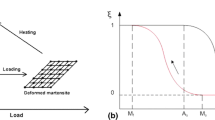Abstract
Future crewed deep space missions will require thermal control systems that can accommodate larger fluctuations in temperature and heat rejection loads than current designs. To maintain the crew cabin at habitable temperatures throughout the entire mission profile, radiators will be required to exhibit turndown ratios (defined as the ratio between the maximum and minimum heat rejection rates) as high as 12:1. Potential solutions to increase radiator turndown ratios include designs that vary the heat rejection rate by changing shape, hence changing the rate of radiation to space. Shape memory alloys exhibit thermally driven phase transformations and thus can be used for both the control and actuation of such a morphing radiator with a single active structural component that transduces thermal energy into motion. This work focuses on designing a high-performance composite radiator panel and investigating the behavior of various SMA actuators in this application. Three designs were fabricated and subsequently tested in a relevant thermal vacuum environment; all three exhibited repeatable morphing behavior, and it is shown through validated computational analysis that the morphing radiator concept can achieve a turndown ratio of 27:1 with a number of simple configuration changes.










Similar content being viewed by others
Notes
The fluid temperature was unable to reach 90 °C in this experiment due to system losses in the tubing.
References
Stephan R (2009) Overview of NASA’s thermal control system development for exploration project. In: SAE ICES
Juhasz A, Peterson G (1994) Review of advanced radiator technologies for spacecraft power systems and space thermal control. NASA STI/Recon Technical Report
NASA (2015) TA 14: thermal management systems. In: NASA Technology Roadmaps
Ochoa D, Vonau W, Ewert M (2009) A comparison between one- and two-loop ATCS architectures proposed for CEV. SAE Techincal Paper
Hill S, Kostyk C, Motil B, Notardonato W, Rickman S, Swanson T (2015) Thermal management systems roadmap: technology area 14. NASA, July 2015
Bannon E, Bower C, Sheth R, Stephan R, Chandrasekhar P, Zay B (2010) “Electrochromic radiator coupon level testing and full scale thermal math modeling for use on altair lunar lander. In: Proceedings of the 40th international conference on environmental systems
Benkahoul M, Chaker M, Margo J, Haddad E, Kruzelecky R, Wong B, Jamroz W, Poinas P (2011) Thermochromic VO2 film deposited on Al with tunable thermal emissivity for space applications. Sol Energy Mater Sol Cells 95(12):3504–3508
Demiryout H, Morrehead D (2009) Electrochromic emissivity modulator for spacecraft thermal management. Sol Energy Mater Sol Cells 93(12):2075–2078
Metts J, Nabity J, Klaus D (2011) Theoretical performance analysis of electrochromic radiators for space suit thermal control. Adv Space Res 47(7):1256–1264
Cognata T, Hartl D, Sheth R, Dinsmore C (2015) A morphing radiator for high-turndown thermal control of crewed space exploration vehicles. In Proceedings of 23rd AIAA/AHS adaptive structures conference, Kissimmee, FL
Hartl DJ, Lagoudas D (2007) Aerospace applications of shape memory alloys
Bertagne CL, Cognata TJ, Sheth RB, Dinsmore CE, Hartl DJ (2017) Testing and analysis of a morphing radiator concept for thermal control of crewed space vehicles. Appl Therm Eng 124(2017):986–1002
Bertagne C, Sheth R, Hartl D, Whitcomb J (2015) Simulating coupled thermal-mechanical interactions in morphing radiators. In: Proceedings of SPIE, active and passive smart structures and integrated systems, San Diego, CA
Bertagne C, Hartl D, Cognata T (2015) Analysis of highly coupled thermal-structural responses in morphing radiative bodies. In: Proceedings of 23rd AIAA/AHS adaptive structures conference, Kissimmee, FL
Bergman TL, Lavine AS, Incropera FP, Dewitt DP (2011) Radiation exchange between surfaces. In: Fundamentals of heat and mass transfer. Wiley, Hoboken, pp 862–864
Lagoudas D (2008) Shape memory alloys: modeling and engineering applications. Spring, New York
Bertagne CL, Chong JB, Whitcomb JD, Hartl DJ, Erickson LR, Sheth RB (2016) Experimental characterization of a shape memory alloy-based morphing radiator. In: AIAA/AHS adaptive structures conference, San Diego, CA
Wescott M, McQuien S, Bertagne C, Whitcomb J, Hartl D, Erickson L (2017) Design and fabrication of a composite morphing radiator panel using high conductivity fibers. In: 25th AIAA/AHS adaptive structures conference, Grapevine, TX
Jones RM (1999) Mechanics of composite materials. Taylor & Francis Inc, Philadelphia
Dassault Systemes of America Corp. (2007) Abaqus analysis user’s manual. Dassault Systemes of America Corp., Woodland Hils, CA
Solar Energy Corporation (2005) LO-MIT RB coating. https://www.solec.org/wp-content/uploads/2012/04/lomitrbcoating.pdf. Accessed 5 Sept 2017
Dynalene, Inc. Dynalene HC series. Whitehall, PA
Bertagne CL, Chong JB, Whitcomb JD, Hartl DJ (2017) Experimental characterization of a composite morphing radiator prototype in a relevant thermal environment. In: AIAA/AHS adaptive structures conference, Grapevine, TX
Acknowledgements
This work was supported by a NASA Space Technology Research Fellowship (NSTRF) under Grant NNX14AM44H and by the Johnson Space Center Independent Research and Development Program. Finite element analysis was conducted using a research license for Abaqus granted by Simulia. SMA procurement and processing was provided by Fort Wayne Metals and Johnson-Matthey. The authors acknowledge Thomas Cognata (Paragon Space Development Corporation) for the initial conceptual discussions, Scott McQuien for developing the framework of the composite design tool, Dr. Mohammad Naraghi and Dr. Ibrahim Karaman (TAMU) for use of their composites lab facilities. The authors also acknowledge James Brown, Tobin Barnes, and Peter Grenfell (NASA JSC, Innovation Design Center) for fabricating the terminal blocks.
Author information
Authors and Affiliations
Corresponding author
Rights and permissions
About this article
Cite this article
Walgren, P., Bertagne, C., Wescott, M. et al. Development and Testing of a Shape Memory Alloy-Driven Composite Morphing Radiator. Shap. Mem. Superelasticity 4, 232–241 (2018). https://doi.org/10.1007/s40830-018-0147-2
Published:
Issue Date:
DOI: https://doi.org/10.1007/s40830-018-0147-2




